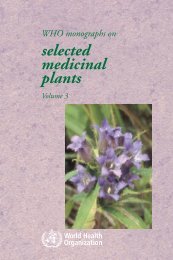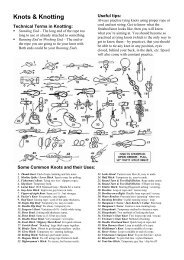Becoming Self-Sufficient for Six Months - Blog by Survival-Goods.com
Becoming Self-Sufficient for Six Months - Blog by Survival-Goods.com
Becoming Self-Sufficient for Six Months - Blog by Survival-Goods.com
Create successful ePaper yourself
Turn your PDF publications into a flip-book with our unique Google optimized e-Paper software.
PERSONAL<br />
PROTECTION EQUIPMENT<br />
At some point in time you will be<strong>com</strong>e profoundly aware of just how vulnerable<br />
you are<br />
to this virus and you will want to take aggressive<br />
steps to protect yourself. Although<br />
you<br />
might be able to stay at home <strong>for</strong> many weeks, and there<strong>by</strong> avoid all contact with<br />
the general public, you may eventually have to venture out of your house <strong>for</strong> something.<br />
If you do, you will surely want protection. From a practical perspective, there<br />
is really nothing that can provide a 100% guarantee that you will not get the flu while<br />
you are out in public, but there are a few reasonable steps you can take that will help<br />
you defend yourself.<br />
Be<strong>for</strong>e you even step out to get the mail, put on a pair of disposable gloves. You have<br />
probably heard this be<strong>for</strong>e,<br />
but the most <strong>com</strong>mon means of transmitting the flu from<br />
human<br />
to human is from hand to face. That is, from your own hand to your own face.<br />
So, if you do <strong>com</strong>e into contact with something that is contaminated, and if you then<br />
touch your nose, your mouth, or your eyes, you can introduce that very contaminant<br />
directly into your body. You may pick it up from “who-knows-where” and it may go<br />
right from your hand to your face and make you sick. That is why hand washing is so<br />
important. Really, you absolutely must put on a pair of disposable gloves be<strong>for</strong>e you<br />
<strong>com</strong>e into contact with any object that has the remotest possibility of being contaminated.<br />
This includes such everyday things as shopping carts, doorknobs, gas pumps,<br />
mail, money, groceries, newspapers, pets, and people–in fact, any object that you have<br />
not personally quarantined or sanitized.<br />
Apart from frequent hand washing and the religious use of disposable gloves, the most<br />
important thing you can do to protect yourself<br />
from the flu is to wear a respirator.<br />
This<br />
device can prevent the inadvertent inhalation of airborne particles that might<br />
contain the virus. Since viruses are transmitted easily from person to person through<br />
the aerosol cocktail of saliva and mucus that is ejected <strong>by</strong> coughs and sneezes, it is<br />
essential that you filter out these contaminated airborne droplets be<strong>for</strong>e they get into<br />
your lungs. That is where the respirator <strong>com</strong>es in.<br />
A respirator is a passive air filter that you wear over your nose and mouth. The most<br />
<strong>com</strong>mon one may be the disposable N95, which is available<br />
<strong>for</strong> about 50¢. Although<br />
this<br />
respirator is widely re<strong>com</strong>mended <strong>by</strong> health agencies, it is not capable of providing<br />
much protection against the flu. The reasons are as follows: most N95 disposable<br />
respirators have a “one size fits all” design, so the perimeter fit is poor; the cheapest<br />
N95 respirators lack an exhalation valve, so the perimeter fit is disturbed when you<br />
exhale; the filter degrades from the water vapor that you exhale; and, the designation<br />
of “95” means that only 95% of the particles that are 0.3 microns or larger will actually<br />
be filtered out. That allows 5% of the potentially infected particles to pass <strong>by</strong> the filter<br />
and enter your mouth or nose. Given these flaws, you should not rely upon N95s <strong>for</strong><br />
protection. What you really need are N100 disposables and P100 reusable half-masks.<br />
Use the disposable N100s <strong>for</strong> limited service when the transmission risk is low, and<br />
use the P100 half-masks <strong>for</strong> extended service in close quarters. If you must care <strong>for</strong><br />
someone who has the flu, you will also need a face shield to protect your eyes from<br />
direct contact with anything that is ejected <strong>by</strong> a cough or sneeze. For additional protection,<br />
have unvented N95s or simple ear-loop medical masks <strong>for</strong> the patient to wear.<br />
<strong>Be<strong>com</strong>ing</strong> <strong>Self</strong>-<strong>Sufficient</strong> <strong>for</strong> <strong>Six</strong> <strong>Months</strong> page 12
















